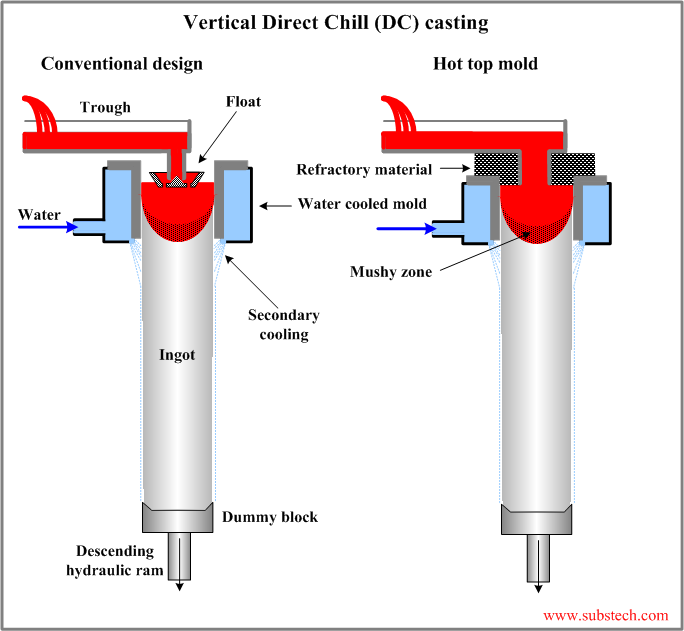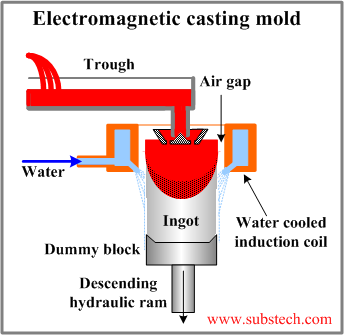Main page
About us
Sliding Bearings Consulting
Advertising Opportunities

to Metals
to Foundry technologies
Direct Chill (DC) casting
Dr. Dmitri Kopeliovich
Direct Chill (DC) casting is a vertical semi-Continuous casting process used for fabrication cylindrical billets or rectangular ingots/blooms from non-ferrous metals such as Aluminum alloys, Copper alloys, Magnesium alloys.
The Direct Chill (DC) cast ingots are further processed by either Extrusion, Rolling or Forging technologies.
The most popular application of the Direct Chill (DC) process is casting aluminum billets for the extrusion.
More than a half of aluminum in the world is cast by the Direct Chill (DC) process.
Direct Chill (DC) casting process
Solidification of the Direct Chill cast metal starts in the water-cooled mold. The melt flows into the mold cavity through a trough and a vertical downspout (nozzle).
The melt flow is controlled by a floating valve increasing the outlet opening of the spout when the melt level goes down or decreasing it when the melt level goes up.
The mold made of aluminum or copper alloys has holes arranged along its bottom end.
Water jets flowing from the holes onto the surface of the emerging ingot provide its direct chilling and solidification.
Most of heat (about 80%) is extracted by the secondary cooling (Direct Chill) and only 20% is removed by heat transfer through the mold wall.
The mold forms a solid shell of the ingot containing a pool of liquid metal. It solidifies and cools down in the zone of the secondary cooling.
The liquid metal pool depth is about 8-20” (200-500 mm).
The mold of the Direct Chill (DC) casting process are usually very short: 3-6” (75-150 mm). The casting rate is normally 2-6 inch/min (50-150 mm/min).
Prior to the casting process a dummy block is inserted into the bottom part of the mold The Direct Chill (DC)casting process starts when the mold cavity with the inserted dummy block is filled with the melt to a predetermined level. Then the dummy block driven by a hydraulic cylinder starts to lower withdrawing the cast ingot from the mold.
The casting process ends when the hydraulic ram reaches its bottom position.
The dimensions of the Direct Chill (DC) castings:
- Billets - 2-20” (50-500 mm)diameter and 160-320” (4-8 m) length. The most typical billet diameter is 8” (200 mm).
- Rectangular ingots - up to 60”x20” (1500×500 mm) and up to 400” (10 m) length.
Designs of the Direct Chill (DC) molds
There are two principal designs of the Direct Chill (DC) casting mold:
- Float controlled melt flow (conventional design)
- Hot top design

The advantages of the hot top design:
- Flow control is not required,
- The melt is protected from oxidation
- Reduces heat losses
Direct Chill (DC) casting in Electromagnetic mold

Electromagnetic mold uses an alternating electromagnetic field generated by the mold itself for repealing the liquid metal from the mold wall.
The mold presents one-loop induction coil (inductor) connected to an AC generator.
The alternating current flowing through the inductor induces eddy currents in the melt. The eddy currents interact with the magnetic field generated by the inductor.
Lorenz forces produced as a result of such interaction hold the melt apart from the mold wall. So the mold forms the ingot shape but does not remove the heat.
The entire heat is extracted by the water jets flowing from the mold onto the ingot surface.
The main advantages of the Direct Chill (DC) casting in electromagnetic mold:
- Good surface quality due to the absence of direct contact and friction between the ingot and mold surfaces.
- Fine Grain structure due to
- 1. The fast cooling provided by the direct chilling only (without heat transfer through the mold wall);
- 2. The melt agitation produced by the electromagnetic forces.
Related internal links
to Metals
to Foundry technologies


